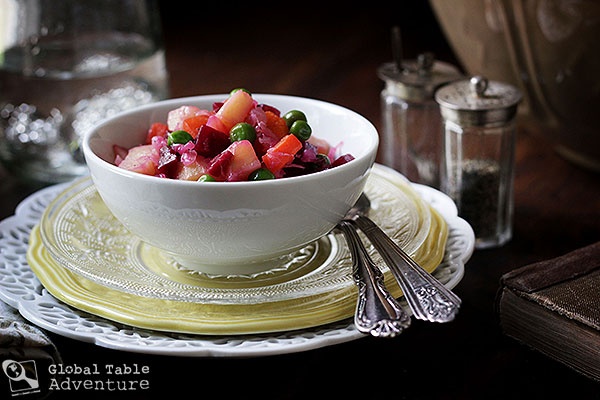Well, hello. Today we’re biting into a very pink salad. There’s not a lot of pink food I can think of besides strawberry ice cream. There’s certainly not a lot of savory pink food. Unless you live in Ukraine, where beets reign supreme. Beets are one of Ukraine’s most beloved root vegetables, and for good reason. They’re packed with fiber, vitamins A, B & C, magnesium, and iron. When they’re not mixed up in borsch, beets make their way into salad vinagret. This salad is a vegan meal unto itself as it includes potatoes, carrots, peas, and sauerkraut. Some recipes swap the peas and sauerkraut for white beans and chopped pickles. Salat Vinagret is funny, because there’s nothing vinegar about it. In fact, there’s no dressing added. The only “tang” comes from the sauerkraut, and the only seasoning from a bit of salt, pepper, and oil. Done and done. The simplicity of this salad makes for a great summer supper, or autumn side dish (perhaps next to a few slices of pot roast). We …
Read More

Wouldn’t it be amazing if bacon could cure every ailment. In the Ukraine, I bet it does. Broken heart? Bacon. Spilled beet juice on your favorite sundress? Bacon. Thursday afternoon existential crisis? Bacon. I’m thinking it’s worth a try. That’s where this pasta bake comes in. “Lokshyna” are Ukrainian noodles, and today we’ve dressed them up with plenty of sizzling bacon, creamy cottage cheese, and a couple of cracked eggs to bind the casserole together. The finishing touch is a happy sprinkling of buttered breadcrumbs (as few or as many as you’d like). One note on authenticity: traditional versions of this recipe are made with fresh egg noodles. On a particularly harried shopping trip, I was unable to locate any… so my version is made with dried noodles. Keep in mind: if you do decide to use fresh noodles, you may need to alter the recipe. This is because fresh noodles can be baked uncooked, but will require more liquid to do so. But, either way, the Ukranian pasta casserole is… awesomely comforting (and perfect …
Read More
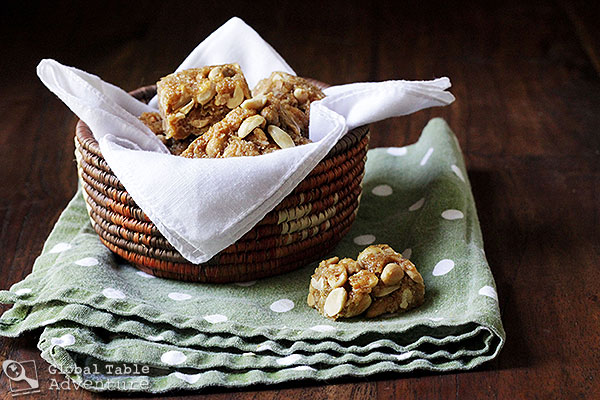
On the simmering streets of Uganda, you can walk up to a street vendor and satisfy your sweet tooth with a big bite of Kashata. Loosely speaking, Kashata is East African brittle. It’s most popular in Uganda and Tanzania. It’s hard, sweet, and all kinds of delicious. I’ve seen Kashata shaped as cubes, balls, and diamonds. Some are flat, some are thick. Just like people, the shape doesn’t matter; it’s all about what’s on the inside. The most glorious Kashata are a blend of peanuts, shredded coconut, and either cinnamon or cardamom. You can also find Kashata made from all coconut or all peanuts. Moreover, sometimes you simply dump in whatever nuts you have on hand. Easy. Makes enough to share. 1-2 dozen (depending on how thin you spread the mixture) Ingredients: 2 cups sugar 1 1/2 – 2 cups peanuts 1 1/2 – 2 cups dried coconut (unsweet) 3/4 tsp ground cardamom (or cinnamon) pinch salt oil, for greasing Method: Let’s go to Uganda, where electricity is optional… because, truth be told, this entire …
Read More
Summer still catwalks through the August air, unabashed and sizzling. There’s still time to grill, still time to sit out under the stars without a coat, or even a hoodie. There’s time to wear out those flipflops and kick back in sunglasses. And there’s still time to try Uganda’s kebabs, adapted from Marcus Samuelsson’s beautiful cookbook Discovery Of A Continent – Foods, Flavors, And Inspirations From Africa. The flavors are intense. Bright lemon juice starts of the explosion. A long marinade brings out bright sparks from the citrus. Then there’s a needling burn from the Harissa, a traditional spice often found in North African cooking. How much heat is there? As much as you can handle. Or as little as you’d like. Tip: You find Harissa mix at Whole Foods in the spice aisle (to be combined with water, olive oil, and crushed garlic), or you can buy a canned paste at a Middle Eastern market. Be sure to add this to taste, as some mixes may be spicier than others. IF you use the …
Read More
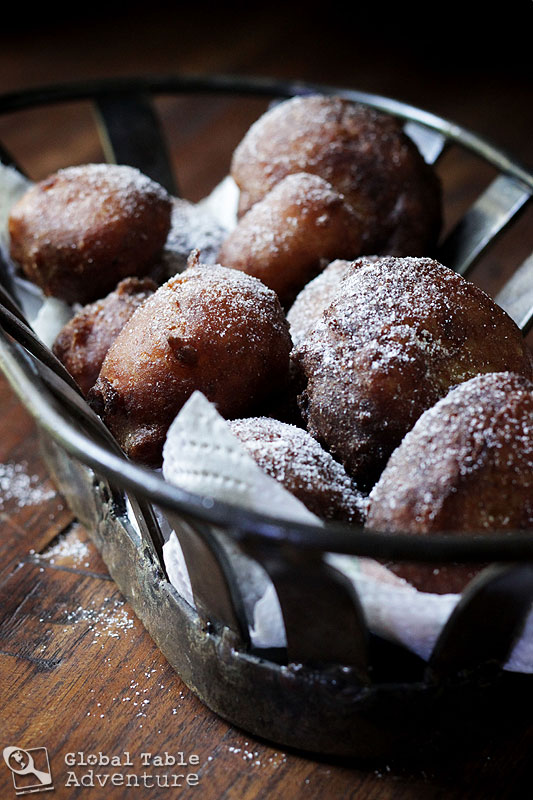
I don’t usually pick my Friday afternoon snacks based on Prince William’s and the Duchess’ eating habits, but this week I couldn’t help myself. The royal couple were fed these amazing fritters during their stay in Tuvalu. What an endorsement. If they’re good enough for royalty, they are good enough for me. Trust me on this: each bite will transport you to magical Tuvalu, way out in the Pacific, where the sun shines brightly, the water sparkles like a smile, and every day feels like a vacation. They are indulgent in the most unapologetic way possible. The fritters contain many local ingredients, most notably coconut and bananas. Not just any bananas, my friends. These are nice, ripe, bananas. After a quick dip in bubbling oil, the fritters emerge soft in the middle and crisp and nut-brown on the outside. A heavy dusting of powdered sugar later and they become the perfect tropical doughnut. Makes 8 large, 12 small Ingredients: Vegetable oil, for frying 2 ripe bananas, rough chopped For the batter: 1/2 cup all-purpose flour 1/2 …
Read More

If you ever make it to Tuvalu, you might as well snatch the Tuna straight out of the water, fillet it in the boat, and enjoy the mild fish right then and there. No cooking required. That’s the local way. But for those who are looking for something a little more tame, Tuna Curry is an authentic, delicious option. The recipe is very typical of the Pacific: it includes locally caught fish and coconut milk from harvested from the in the back yard, plus a bunch of imported ingredients. Imports are necessary because very little can grow in Tuvalu. The curry powder exudes Indian influence, which runs rampant in Oceania, as well as soy sauce, a definite nod to Tuvalu’s Asian neighbors. Even things like ginger and garlic are imported. Shipments of goods arrive once a month, weather permitting. This means, if you’re pantry runs dry, and the store runs out, then you’ll just have to wait until the giant vessel anchors offshore. And when it does? All hands on deck… Recipe adapted from Andy Explores. …
Read More

Imagine living in a place that has a National Holiday called “Melon Day.” You could be surrounded by more than 400 kinds of melon, including some 50 varieties of watermelon.* The cool, sweet flesh would fill your belly and spirit. Eating it would definitely make you smile. And spreading it on bread? Even better. If any of this appeals to you, you might want to consider moving to Turkmenistan. These lovely people have celebrated Melon Day since 1994, and they don’t plan to stop eating the sweetness anytime soon. When I read in The World Cookbook for Students that Watermelon Jam is a thing in Turkmenistan (particularly when served on toast with tea), I knew we had to try it. I made a nice batch of jam from half a regular watermelon. Tastes like jarred sunshine. What a great gift to share with friends and family! Perhaps with a spot of tea… NOTE: I used Pamona’s Universal Pectin because it allows me to add less sugar to the mix (just 2 cups). I found Pamona’s at Whole Foods, though …
Read More
What happens when you eat a lot of international food, but still get in a rut? Is it like when you live by the sea but get tired of looking at the lapping waves (is that even possible?). It’s so easy (and delicious), to return to old favorites like stuffed grape leaves, hummus and tabbouleh, but sometimes a little shakedown is in order. We’re big tabbouleh eaters in this house, so when I found out there’s a Turkish version of this popular bulgur salad, you can bet I jumped on board. This guy knows what I’m talking about… He’s been waiting for a bite for nearly three centuries. What makes kisir different from mainstream Tabbouleh is the addition of two ingredients: tomato paste and pepper paste. These stain the bulgur grains orange-red, and gives the finished dish a rich, earthy flavor. If you use hot pepper paste, the kisir will also go down with a lovely burn. And then there’s a bit more red, too. Say “Merhaba,” or “hello” to a couple of tomatoes from my garden… I was so …
Read More
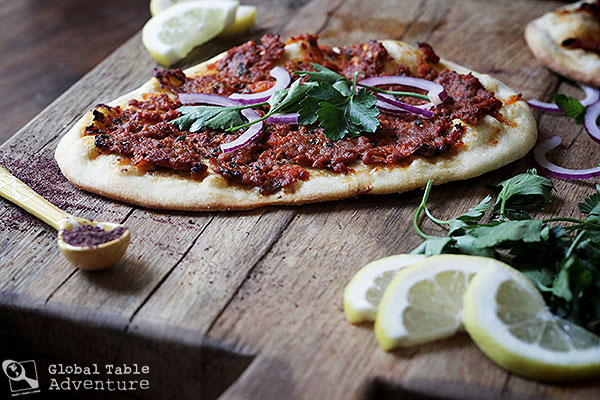
Lahmacun is Turkey’s answer to pizza. The flavors are rich and deep, like an old love story. And, like any good love story, each bite makes my knees sink a little closer to the floor. Why? Because of the layers of flavor. This is no “jarred sauce” affair. This is no mess of waxy cheese. Lahmacun is pure, unadulterated ingredients – as fresh and intense as mother nature grew them. The version we made today includes lamb, olive oil, tomatoes, garlic, tomato paste, paprika, mint and parsley. There’s even a gated onion to provide a sweet background note. The flavors come together to create an unbelievable explosion of flavor. Once baked, Lahmacun is a DIY dream. Diners choose their own toppings and pile them on. In Turkey, you can find everything from pickles and lettuce, to onions and lemon juice. It’s an awesome way to get kids involved and to work through dinner party doldrums. Ava had great fun adding onion, parsley and lemon juice to hers… plus a few sprinklings of sumac (a spice with a …
Read More
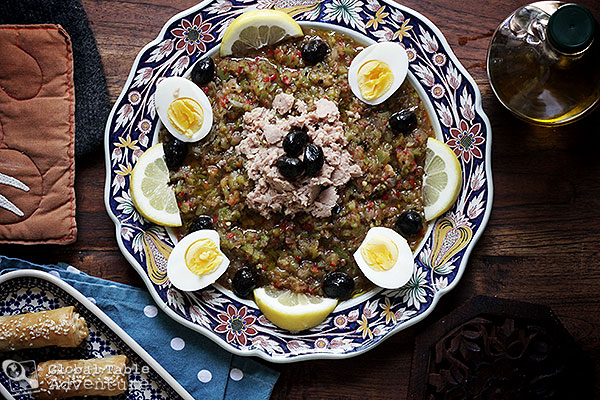
Usually, the food we grill stays whole. We put it on a bun, or we eat it with our hands. But today’s Tunisian Grilled Salad takes a different approach. The charred vegetables – peppers, onion, tomatoes – are pulsed together into a chunky mixture, then served with flaked tuna, and hard boiled egg. This salad has body. Much of the intensity comes off the grill, from the raw garlic, hot chili peppers, and the caraway seeds, all of which can be tempered to taste. Please, please, please… let this salad meld for at least an hour before eating. This will give the bite time to mellow. Because you wouldn’t want to serve your guests a grouchy salad. Mellow is much nicer. UPDATED 2015: Caraway cut down from 1 Tbsp to 1 teaspoon. Adapted from Clifford A. Wright’s A Mediterranean Feast. Serves 4-6 Ingredients: 3 green bell peppers 3 red chili peppers (like red fresno) 2 tomatoes (or 3 small) 1 onion, peeled and quartered (leave stem on to help hold it together) 3 cloves garlic 1 tsp caraway …
Read More
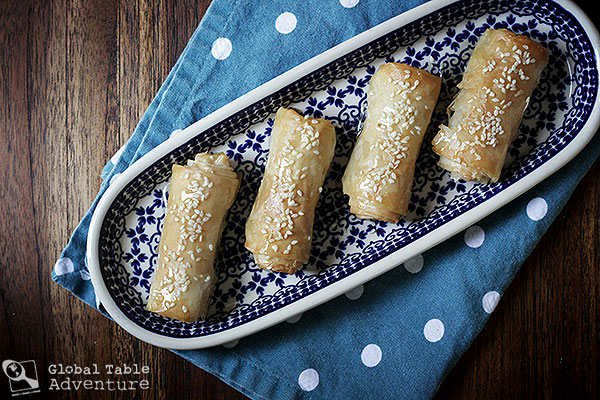
Every wedding, every baby shower, every birthday… every party… needs a smile. And by that, I mean, something that is delectable, not just to the spirit, but to the heart. Perhaps it’s an epic DJ known for Bollywood Dancing. Or perhaps it’s something as simple as a platter of Tunisian cigars, filled with crushed almonds, honey, orange blossom water, and cinnamon…Oh, and there’s a fair kiss of melted butter on them, too. These cigars are rather like baklava, but the orange blossom water makes them more floral, in a dreamy sort of way. The sticky, sweet mixture is guaranteed to get you and your guests licking their fingers. There will be murmurs and smiles. “What is that,” they’ll ask. And you know they’ll be talking about the orange blossom water. So fragrant, yet so delicate. Around the world, the word “samsa” is used to describe many, many different filled pastries, from meats to sweets. In Tunisia these are samsa. Every, last, glistening morsel is yours for the taking. Important note: Thaw the filo dough according to package instructions before …
Read More
In Trinidad and Tobago they say “Don’t pick fruits after 6 p.m., the tree is sleeping.” I’m not exactly sure what the tree would do to retaliate if you interrupt its sleep … but I do know that when I don’t get my sleep, I’m not only gruffy, but I can’ t focus on anything. I’m so tired that my work suffers. I pout. I play with my hair. I pace rooms. I can’t bear fruit, so to speak. So. Let’s avoid picking fruit from the tree after six, both literally and figuratively. Instead, let’s enjoy fruit in our rice. I first read about orange rice in The World Cookbook for Students. Apparently, this is a popular side dish in parts of Trinidad and Tobago. And for good reason. When cooked with orange juice, rice becomes sweet, tangy, and makes the perfect complement to spicy food. Now. There is nothing subtle about replacing all the water with O.J., so if you’d like to start off with something more mild, try using half water (or broth) and half O.J. …
Read More

